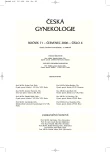„See and Treat“ Hysteroscopy: Limits of Intrauterine Pathology Bulk
Authors:
D. Kužel 1; D. Tóth 2; L. Hrazdírová 1; M. Mára 1; Z. Fučíková 1
Authors‘ workplace:
Gynekologicko-porodnická klinika 1. LF UK a VFN, Praha, přednosta prof. MUDr. A. Martan, DrSc.
1; Clinique St. Germain, Brive la Gaillarde, France
2
Published in:
Ceska Gynekol 2006; 71(4): 325-328
Category:
Original Article
Overview
Objective:
To evaluate bulk limits of intrauterine pathology for „see and treat“ hysteroscopy.
Type of study:
A retrospective observational study.
Setting:
Department of Gynaecology and Obstetrics, First Faculty of Medicine, Charles University Prague and General Teaching Hospital Prague.
Methods:
200 mg of Indomethacin was administered to the patients by rectum 2 hours before procedure. „See and treat“ procedures were performed with „Versascope“ in awake patients without any peroperatively admistered analgesia or anaesthesia. As a „see and treat“ were managed 796 endometrial polyps, 125 submucous myomas, as well as 62 cases of intrauterine synechias.
Conclusions:
endometrial polyps up to 1,5 cm, pedunculated submucous myomas up to 1,0 cm as well as fibroid adhesiones obliterated no more than 1/3 of uterine cavity can be managed as „see and treat“ procedures with a high compliance of the patients.
Key words:
office hysteroscopy, vaginoscopic approach, endometrial biopsy, endometrial polyp, submucous myoma, intrauteine adhesions
Labels
Paediatric gynaecology Gynaecology and obstetrics Reproduction medicineArticle was published in
Czech Gynaecology

2006 Issue 4
Most read in this issue
- Etiopathogenesis of the Prolapsed Vaginal Vault after Hysterectomy
- Actual Management of Pregnancies at Risk for Fetal Anemia
- Harmatoma of the Breast – Case Report
- Gynecological Aspects of Thyroid Disorders. A Review
